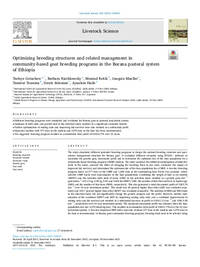Optimizing breeding structures and related management in community-based goat breeding programs in the Borana pastoral system of Ethiopia

Authors:
The study simulated different potential breeding programs to design the optimal breeding structure and operational management structure for Borana goat. It evaluated different scenarios using ZPLAN+ software to maximize the genetic gain, discounted profit and to determine the optimum size of the base population for a community-based breeding program (CBBP) nucleus. The study analyzed the different combinations of objective traits in the index, assessed the effect of changing the breeding buck to doe ratio, evaluated the impact of improved kid survival, and determined the optimum size of the base population for a CBBP. A two-tier breeding program based on 577 does in the CBBP and 1,006 does in the surrounding base flocks was assumed, where selected CBBP bucks were disseminated to the base populations. Combining the weight of kids at six months (SMWT) and the lactation milk yield of dams (LMY) in the selection index resulted in a genetic gain doe−1 generation−1 of 0.13 kg, 0.58 kg, 0.02 and 0.004 for SMWT, LMY, the number of kids that survived to market age (NKS) and the number of kids born (NKB), respectively. This also generated a total discounted profit of US$5.76 doe−1 over 10 year investment period. This result was 30 percent higher than when LMY was evaluated separately and 225.7 percent higher than when SMWT was evaluated separately. The addition of NKB and NKS traits in the selection index did not significantly change the genetic progress and the profit. However, further optimization of the combined SMWT and LMY by improving mating ratio only, and a combined improvement in mating ratio and kid survival rate resulted in a substantial increase in profit to US$11.13 doe−1 and US$15.58 doe−1, respectively over 10 year investment period. The maximum discounted profit was attained when the base population size was 3,579 breeding does. This resulted in accumulated total profit of US$14,776 over the 10 year investment period. A two-tier dispersed CBBP with a unit size of about 577 does in the nucleus and 3,579 does in the base is recommended. In Borana goat community-breeding program, breeding buck need to be selected using an index combining at least own live weight and dam milk yield performance. Essential requirements for ensuring the sustainability of such programs are also discussed in the paper.
